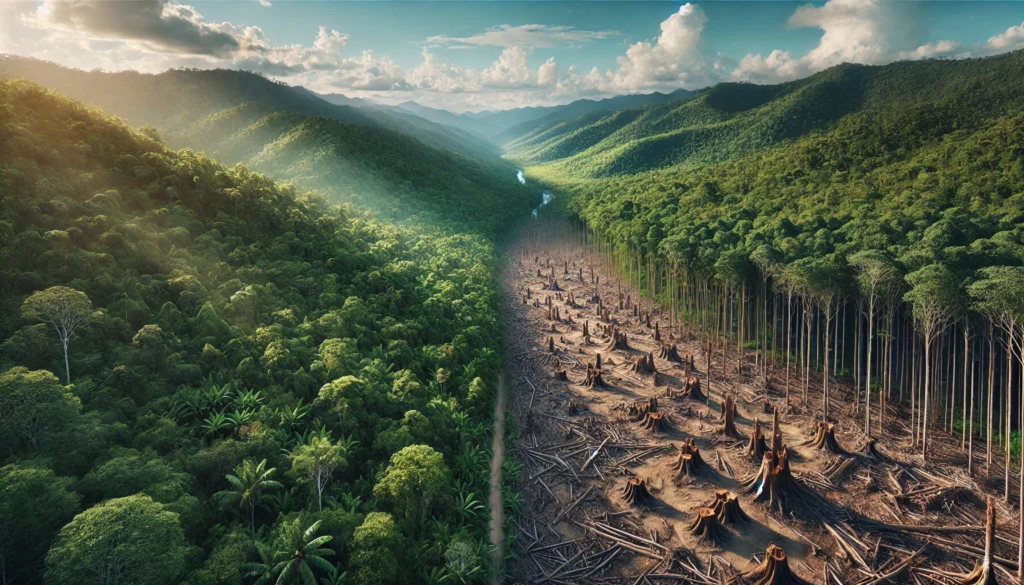Hey there, eco-warriors and nature enthusiasts! Ready to embark on a wild journey through the world of environmental advocacy? Buckle up, because we’re about to dive deep into the green scene and learn how to become the ultimate voice for Mother Nature. In this blog post, we’ll explore the ins and outs of environmental protection, discover why it’s crucial to speak up for our planet, and uncover some hilarious (and sometimes face-palm-worthy) facts about our relationship with the environment. So, grab your reusable water bottle, put on your thinking cap (made from recycled materials, of course), and let’s get started!
Why Should We Care About Environmental Protection?
Alright, let’s address the elephant in the room (no, not an actual elephant – we’re trying to protect those, remember?). Why should we give a hoot about environmental protection? Well, my dear friend, the answer is simple: we kind of live here. Earth is our home, and unless Elon Musk gets his Mars colony up and running ASAP, we’re stuck with this beautiful blue marble for the foreseeable future.
But seriously, environmental protection is crucial for maintaining the delicate balance of ecosystems, preserving biodiversity, and ensuring a sustainable future for generations to come. It’s not just about hugging trees (although that’s a pretty great stress-reliever) – it’s about safeguarding our own survival and the well-being of every living creature on this planet.
Think about it: clean air, fresh water, fertile soil, and a stable climate are all essential for our existence. Without these basic elements, we’d be in a pickle – and not the tasty kind you put on a sandwich. Environmental protection is our insurance policy against a future where we’re left high and dry (literally, in some cases) without the resources we need to thrive.
The State of Our Environment: A Reality Check
Now, I hate to be the bearer of bad news, but our planet is facing some serious challenges. Climate change, deforestation, pollution, and loss of biodiversity are just a few of the environmental issues we’re grappling with. It’s like Mother Nature is sending us a distress signal, and we need to pick up the phone ASAP.
Let’s take a look at some eye-opening statistics that might just make you want to hug a tree (or at least recycle that empty soda can):
| Environmental Issue | Alarming Statistic |
|---|---|
| Climate Change | Global temperatures have risen by about 1°C since pre-industrial times |
| Deforestation | Approximately 18.7 million acres of forests are lost annually |
| Plastic Pollution | 8 million metric tons of plastic enter the oceans every year |
| Biodiversity Loss | 1 million species are at risk of extinction |
| Air Pollution | 9 out of 10 people breathe air containing high levels of pollutants |
Yikes! Those numbers are scarier than a horror movie marathon on Halloween night. But don’t worry, all hope is not lost. This is where environmental advocacy comes in – it’s time to channel your inner superhero and fight for the planet!
What Exactly is Environmental Advocacy?
Defining the Green Crusade
Environmental advocacy is like being a lawyer for the planet – minus the fancy suit and briefcase (although you can totally rock those if you want). It’s all about speaking up for nature, raising awareness about environmental issues, and pushing for policies and actions that protect our precious ecosystems.
Think of yourself as Mother Nature’s personal PR agent. Your job is to spread the word about environmental concerns, educate others on sustainable practices, and inspire action to create positive change. It’s like being a social media influencer, but instead of promoting the latest fashion trends, you’re promoting a healthier planet. #SaveThePlanet, anyone?
Types of Environmental Advocacy
Environmental advocacy comes in many shapes and sizes, kind of like a box of eco-friendly chocolates. Here are a few common types:
- Grassroots Advocacy: This is the boots-on-the-ground approach, where individuals and local groups work together to address environmental issues in their communities. It’s like being part of a green flash mob, but with more purpose and less choreographed dancing.
- Legislative Advocacy: This involves lobbying lawmakers and pushing for environmental policies and regulations. It’s like playing chess with politicians, except the stakes are much higher, and the game pieces are made of recycled materials.
- Corporate Advocacy: This type of advocacy focuses on pressuring businesses to adopt more sustainable practices. It’s like being a eco-conscious version of Gordon Ramsay, but instead of yelling about undercooked scallops, you’re calling out companies on their environmental shortcomings.
- Media Advocacy: This involves using various media channels to raise awareness about environmental issues. It’s like being an environmental influencer, but instead of posting selfies, you’re sharing hard-hitting facts about climate change (although a well-timed selfie with a endangered species couldn’t hurt).
Why Your Voice Matters: The Power of Individual Action
Now, I know what you’re thinking: “I’m just one person. What difference can I possibly make?” Well, my friend, let me tell you a little secret: every big change starts with a single voice. It’s like that old saying about a butterfly flapping its wings and causing a hurricane on the other side of the world – except in this case, your actions could lead to a positive storm of environmental change!
Individual action is the cornerstone of environmental advocacy. When you speak up for nature, you’re not just adding your voice to the chorus – you’re inspiring others to join in. It’s like starting a Mexican wave at a sports game, but instead of doing the wave, people are adopting sustainable practices and fighting for environmental protection.
Here are a few reasons why your voice is more powerful than you might think:
- Ripple Effect: Your actions and words can inspire friends, family, and even strangers to make eco-friendly choices. It’s like being a green influencer, minus the sponsored posts for bamboo toothbrushes (although those are pretty cool).
- Collective Impact: When individuals come together, their combined efforts can create significant change. It’s like a environmental flash mob, but instead of dancing, you’re all planting trees or cleaning up beaches.
- Market Influence: Your consumer choices send a message to companies about the demand for sustainable products. It’s like voting with your wallet, but instead of electing politicians, you’re supporting eco-friendly businesses.
- Policy Pressure: When enough individuals speak up, policymakers take notice. It’s like a green version of “The Voice,” where your environmental concerns get a chance to be heard on the main stage.
How to Become an Environmental Advocate: Your Green Superhero Origin Story
Step 1: Educate Yourself
Before you can save the world, you need to know what you’re saving it from. Start by educating yourself about environmental issues. Read books, watch documentaries, and follow reputable environmental organizations. It’s like going to superhero school, but instead of learning how to fly, you’re learning about the carbon cycle and the impacts of plastic pollution.
Step 2: Start Small and Local
You don’t need to solve global warming overnight (although that would be pretty impressive). Begin by making changes in your own life and community. Reduce your carbon footprint, participate in local clean-up events, or start a recycling program at your workplace. It’s like being a neighborhood watch captain, but for the environment.
Step 3: Use Your Voice
Speak up about environmental issues on social media, write letters to your representatives, or start a blog. Share your knowledge and passion with others. It’s like being a town crier, but instead of announcing the time, you’re spreading awareness about the importance of protecting our planet.
Step 4: Join Forces
Connect with like-minded individuals and organizations. Join environmental groups, attend rallies, or volunteer for conservation projects. It’s like assembling your own eco-Avengers team, minus the spandex suits (although if you want to wear one, go for it – we don’t judge).
Step 5: Lead by Example
Practice what you preach by adopting sustainable habits in your daily life. Use reusable bags, reduce your meat consumption, or switch to renewable energy. It’s like being a green influencer, but instead of posting about your awesome eco-friendly lifestyle, you’re actually living it (but feel free to post about it too – spread that green inspiration!).
Tools of the Trade: Essential Skills for Environmental Advocates
Every superhero needs their gadgets, and environmental advocates are no exception. Here are some essential skills to add to your eco-warrior toolkit:
Communication Skills
Being able to clearly and persuasively communicate environmental issues is crucial. You need to be able to explain complex concepts in simple terms, like describing climate change to your grandma without putting her to sleep. Practice your elevator pitch about why protecting the environment matters – you never know when you’ll find yourself in an actual elevator with a policymaker!
Research Skills
Stay up-to-date with the latest environmental research and data. It’s like being a detective, but instead of solving crimes, you’re uncovering the truth about environmental issues. Just remember: with great knowledge comes great responsibility (and the occasional urge to bore your friends with fascinating facts about composting).
Networking Skills
Build relationships with other advocates, organizations, and decision-makers. It’s like creating your own environmental LinkedIn, but with more trees and fewer annoying recruitment messages.
Problem-Solving Skills
Environmental issues are complex and require creative solutions. Sharpen your problem-solving skills by tackling local environmental challenges. It’s like playing a real-life version of SimCity, but instead of building virtual cities, you’re finding ways to make your actual city more sustainable.
Persistence
Environmental advocacy can be a long game. You need to be persistent in the face of setbacks and slow progress. It’s like playing a marathon game of Monopoly, but instead of collecting properties, you’re accumulating small wins for the environment.
Overcoming Challenges: Navigating the Obstacle Course of Environmental Advocacy
Let’s face it: being an environmental advocate isn’t always a walk in the park (although actual walks in the park are highly recommended). You’ll face challenges along the way, but don’t worry – we’ve got some tips to help you overcome them:
Challenge: Eco-Anxiety
Dealing with the constant barrage of negative environmental news can be overwhelming. It’s like binge-watching a dystopian series, except it’s real life.
Solution: Practice self-care and focus on positive actions. Celebrate small victories and remember that every effort counts. It’s like being a cheerleader for the planet – and yourself!
Challenge: Skepticism and Denial
You’ll encounter people who are skeptical about environmental issues or outright deny their existence. It’s like trying to convince someone that the Earth is round… oh wait, we’re still doing that too?
Solution: Stay patient and focus on presenting facts and evidence. Use relatable examples and appeal to common values. It’s like being a green version of Sherlock Holmes, presenting your case with logic and charm.
Challenge: Feeling Overwhelmed
The sheer scale of environmental problems can make you feel like you’re trying to empty the ocean with a teaspoon.
Solution: Break big issues into smaller, manageable actions. Focus on what you can control and celebrate progress, no matter how small. It’s like eating an elephant (not literally, of course) – one bite at a time.
Challenge: Burnout
Constant advocacy can lead to burnout. It’s like running a marathon, but the finish line keeps moving further away.
Solution: Take breaks, practice self-care, and remember to enjoy nature. It’s okay to step back and recharge. Think of it as putting on your own oxygen mask before helping others – you can’t save the planet if you’re running on empty.
Success Stories: Environmental Advocacy Wins to Inspire You
Need a little motivation to keep fighting the good fight? Check out these inspiring environmental advocacy success stories:
- The Ozone Layer Recovery: Thanks to global efforts to ban ozone-depleting substances, the ozone layer is healing. It’s like giving the Earth’s sunscreen a much-needed boost!
- The Rise of Renewable Energy: Advocacy for clean energy has led to significant growth in renewable energy sources. It’s like watching the planet switch from coffee to green smoothies for its energy boost.
- Marine Protected Areas: Advocacy efforts have resulted in the creation of large marine protected areas, safeguarding ocean ecosystems. It’s like creating underwater national parks, but with more fish and fewer tourists.
- The Ban on Single-Use Plastics: Many countries and cities have banned or restricted single-use plastics due to advocacy efforts. It’s like giving plastic bags the ultimate “it’s not you, it’s me” breakup speech.
- The Paris Agreement: While not perfect, this global accord on climate change action was a significant step forward. It’s like getting all the countries of the world to agree on where to go for dinner – a minor miracle!
The Future of Environmental Advocacy: What’s Next?
As we look to the future, environmental advocacy is evolving. Here are some trends to watch:
Technology and Data-Driven Advocacy
With the rise of big data and AI, advocates are using technology to track environmental changes, predict impacts, and propose solutions. It’s like having a crystal ball, but instead of seeing the future, you’re seeing real-time data on deforestation rates.
Intersectional Environmentalism
There’s a growing recognition that environmental issues are interconnected with social justice issues. Future advocacy efforts will likely focus more on the intersection of environmental protection and human rights. It’s like realizing that the Earth’s ecosystem is one big, interconnected web – pull on one thread, and the whole thing moves.
Youth-Led Movements
Young people are increasingly taking the lead in environmental advocacy. From school strikes to social media campaigns, the next generation is making their voices heard. It’s like watching the kids’ table at Thanksgiving dinner suddenly start making all the important decisions – and doing a pretty good job of it!
Corporate Accountability
As consumers become more environmentally conscious, there’s likely to be increased pressure on corporations to adopt sustainable practices. It’s like playing a global game of “Green Light, Red Light” with multinational companies.
Your Call to Action
So, there you have it, folks – your crash course in environmental advocacy! Remember, you don’t need a cape or superpowers to be a hero for the planet (although if you have those, definitely use them). All you need is passion, knowledge, and the willingness to speak up for nature.
Whether you’re starting small by reducing your own environmental impact or diving headfirst into grassroots organizing, every action counts. It’s like building a giant LEGO structure of environmental protection – each piece matters, no matter how small.
So, what are you waiting for? Get out there and start advocating for the environment! Write that letter to your representative, organize that community clean-up, or simply have a conversation about environmental issues with a friend. Remember, in the words of the great Dr. Seuss (who was quite the environmental advocate himself), “Unless someone like you cares a whole awful lot, nothing is going to get better. It’s not.”
Now go forth and be the change you wish to see in the world – Mother Nature is counting on you!
Disclaimer: This blog post is intended for informational purposes only. While we strive for accuracy, environmental data and statistics may change over time. Please consult the latest scientific research and reputable environmental organizations for the most up-to-date information. If you notice any inaccuracies, please report them so we can correct them promptly. Remember, staying informed is key to effective environmental advocacy!




